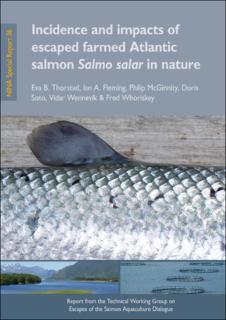| dc.description.abstract | Since the mid-1960s, Atlantic salmon Salmo salar farming has grown into a large industry within and beyond the native range of the species. Norway, Chile, Scotland and Canada are the largest producers (46, 31, 10 and 7% of total production in 2005). A number of environmental concerns have arisen from the phenomenal growth of the industry. This report from the Technical Working Group on Escapes of the Salmon Aquaculture Dialogue aims at examining and evaluating i) the incidence and impacts of escaped farmed salmon in nature, and ii) the technologies and efforts to prevent escapes and to reduce their impacts upon wild salmon and the environment. This document:
• reviews the status of current research and our understanding of the issues,
• identifies significant conclusions/issues resolved by past research, and
• documents specific knowledge gaps and research needs.
Detailed information on salmon production, reported escapes from fish farms and monitoring of escaped farmed salmon in nature is given for each of the salmon producing countries. Escapes from fish farms occur from marine net pens in all salmon producing countries, as both repeated “trickle” losses of relatively small numbers of fish, and through large-scale episodic events. Numbers of farmed salmon escaping to the wild are large relative to the abundance of their wild conspecifics. Nearly all salmon producing countries have established routines for reporting at least large-scale escapes from sea cage sites, but the magnitude of unreported escapes is unknown. Information on low-level leakage and escapes from freshwater hatcheries remains uniformly poor.
Negative effects by escaped farmed salmon on wild Atlantic salmon populations have been scientifically documented. Negative effects include both ecological interactions and genetic impacts of inter-breeding. A large number of studies point to negative effects, and outcomes for wild populations are either mostly negative and at best neutral. It has been shown that inter-breeding of farm with wild salmon can result in reduced lifetime success, lowered individual fitness, and decreases in production over at least two
generations.
Nearly one third of the total world production of Atlantic salmon is in regions where the species is exotic. There is evidence of successful spawning of Atlantic salmon in three streams in British Columbia, Canada, but whether escaped Atlantic salmon have established breeding populations along the North American West Coast still remains uncertain. Spawning of escaped farmed Atlantic salmon has not been documented in Chile or Tasmania. The Atlantic salmon is a poor colonizer outside its native range. The probability that escaped Atlantic salmon will establish populations where the species is exotic seems low, but the possibility cannot be ruled out. It is difficult to predict if or how Atlantic salmon will adapt to the regions where they are exotic, partly because research to study potential impacts in many of these regions is limited.
The most important management issue at present is the need to reduce the numbers of escaped farmed salmon in nature. Among technologies and efforts to reduce impacts of escapes, sterilisation and farm exclusion zones look to be among the most promising, although significant research to fine-tune and study the effects of these approaches is needed. Given the compelling evidence pointing towards a high risk of negative impacts by escaped farmed salmon on wild salmon populations (or on native fish/other organisms in the case of escapes as alien species), and recognising the need to continually improve on our knowledge of the interactions between cultured and wild Atlantic salmon, the members of this working group would like to emphasise that the most pressing research priorities are linked to: 1) technologies and efforts for containment (escape prevention), and 2) approaches to reduce impacts of escapees. | en_US |
